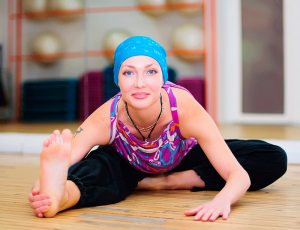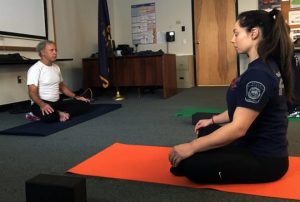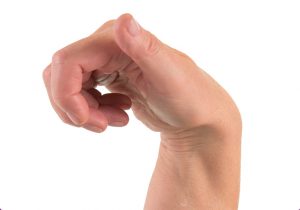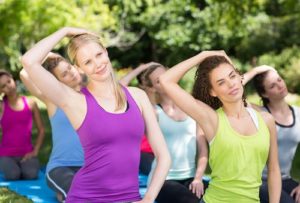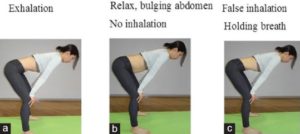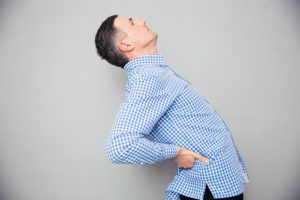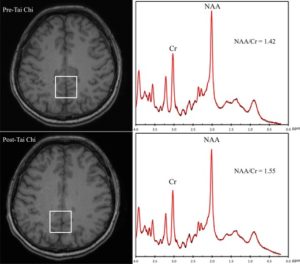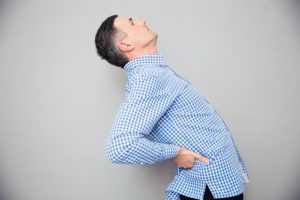
Reduce Low Back Pain with Yoga
By John M. de Castro, Ph.D.
“For most of our lives, we take our backs for granted. But at some point in just about everyone’s life, our backs revolt and remind us that they need love and attention too. Thankfully, for many of us, the pain is only temporary. But for others, it can be much more debilitating—and much more frustrating. In severe cases, medical attention may be necessary, but if your pain is less severe, yoga may be able to help by strengthening the back, stretching it and improving circulation to the spine and nerves.” – Liz Rosenblum
Low Back Pain is the leading cause of disability worldwide and affects between 6% to 15% of the population. It is estimated, however, that 80% of the population will experience back pain sometime during their lives. There are varied treatments for low back pain including chiropractic care, acupuncture, biofeedback, physical therapy, cognitive behavioral therapy, massage, surgery, opiate pain killing drugs, steroid injections, and muscle relaxant drugs. These therapies are sometimes effective particularly for acute back pain. But, for chronic conditions the treatments are less effective and often require continuing treatment for years and opiate pain killers are dangerous and can lead to abuse, addiction, and fatal overdoses. Obviously, there is a need for safe and effective treatments for low back pain that are low cost and don’t have troublesome side effects.
Pain involves both physical and psychological issues. The stress, fear, and anxiety produced by pain tends to elicit responses that actually amplify the pain. So, reducing the emotional reactions to pain may be helpful in pain management. Mindfulness practices have been shown to improve emotion regulation producing more adaptive and less maladaptive responses to emotions. Indeed, mindfulness practices are effective in treating pain and have been shown to be safe and effective in the management of low back pain. Yoga practice has been shown to have a myriad of health benefits. These include relief of chronic pain. Yoga practice has also been shown to be effective for the relief of chronic low-back pain. Many forms of yoga focus on the proper alignment of the spine, which could directly address the source of back and neck pain for many individuals. So, it makes sense to further explore the effectiveness of yoga therapy for chronic low back pain.
In today’s Research News article “Yoga treatment for chronic non-specific low back pain.” (See summary below or view the full text of the study at: https://www.ncbi.nlm.nih.gov/pmc/articles/PMC5294833/ ), Wieland and colleagues review and summarize the published research studies that examined the effectiveness of yoga practice for the treatment of chronic low back pain. They discovered only 12 published research studies on the subject. They reported that the studies found that yoga practice in comparison to no-exercise control conditions produced small but significant improvements in pain and back function that were maintained for 6 months. This demonstrates that yoga practice is effective for back pain but does not allow for a determination of whether exercise in general or yoga specifically was effective. So, they looked at studies of yoga practice in comparison to other forms of exercise and found that yoga practice produced small but significantly better improvements than other exercises in pain but equivalent improvements in back function. When yoga practice was combined with other exercises it did not produce significantly greater benefits than exercise alone.
The summary suggests that yoga practice and other exercises are safe and effective treatments for chronic low back pain that can produce lasting improvements in pain and back function. They found evidence that yoga practice may be slightly better than other exercises in reducing pain, but there is no additional benefit of combining yoga with other exercises. Hence, yoga practice is an acceptable, safe, and effective alternative to drug and surgical treatments that has small but significant benefits for the relief to the suffering of people with chronic low back pain.
So, reduce low back pain with Yoga.
“a structured yoga program may be an alternative to physical therapy for people with chronic low-back pain, depending on individual preferences, availability, and cost.” – NCCIH
CMCS – Center for Mindfulness and Contemplative Studies
This and other Contemplative Studies posts are also available on Google+ https://plus.google.com/106784388191201299496/posts and on Twitter @MindfulResearch
Study Summary
Wieland, L. S., Skoetz, N., Pilkington, K., Vempati, R., D’Adamo, C. R., & Berman, B. M. (2017). Yoga treatment for chronic non-specific low back pain. The Cochrane Database of Systematic Reviews, 1, CD010671. http://doi.org/10.1002/14651858.CD010671.pub2
Abstract
Background
Non-specific low back pain is a common, potentially disabling condition usually treated with self-care and non-prescription medication. For chronic low back pain, current guidelines state that exercise therapy may be beneficial. Yoga is a mind-body exercise sometimes used for non-specific low back pain.
Objectives
To assess the effects of yoga for treating chronic non-specific low back pain, compared to no specific treatment, a minimal intervention (e.g. education), or another active treatment, with a focus on pain, function, and adverse events.
Search methods
We searched CENTRAL, MEDLINE, Embase, five other databases and four trials registers to 11 March 2016 without restriction of language or publication status. We screened reference lists and contacted experts in the field to identify additional studies.
Selection criteria
We included randomized controlled trials of yoga treatment in people with chronic non-specific low back pain. We included studies comparing yoga to any other intervention or to no intervention. We also included studies comparing yoga as an adjunct to other therapies, versus those other therapies alone.
Data collection and analysis
Two authors independently screened and selected studies, extracted outcome data, and assessed risk of bias. We contacted study authors to obtain missing or unclear information. We evaluated the overall certainty of evidence using the GRADE approach.
Main results
We included 12 trials (1080 participants) carried out in the USA (seven trials), India (three trials), and the UK (two trials). Studies were unfunded (one trial), funded by a yoga institution (one trial), funded by non-profit or government sources (seven trials), or did not report on funding (three trials). Most trials used Iyengar, Hatha, or Viniyoga forms of yoga. The trials compared yoga to no intervention or a non-exercise intervention such as education (seven trials), an exercise intervention (three trials), or both exercise and non-exercise interventions (two trials). All trials were at high risk of performance and detection bias because participants and providers were not blinded to treatment assignment, and outcomes were self-assessed. Therefore, we downgraded all outcomes to ‘moderate’ certainty evidence because of risk of bias, and when there was additional serious risk of bias, unexplained heterogeneity between studies, or the analyses were imprecise, we downgraded the certainty of the evidence further.
For yoga compared to non-exercise controls (9 trials; 810 participants), there was low-certainty evidence that yoga produced small to moderate improvements in back-related function at three to four months (standardized mean difference (SMD) −0.40, 95% confidence interval (CI) −0.66 to −0.14; corresponding to a change in the Roland-Morris Disability Questionnaire of mean difference (MD) −2.18, 95% −3.60 to −0.76), moderate-certainty evidence for small to moderate improvements at six months (SMD −0.44, 95% CI −0.66 to −0.22; corresponding to a change in the Roland-Morris Disability Questionnaire of MD −2.15, 95% −3.23 to −1.08), and low-certainty evidence for small improvements at 12 months (SMD −0.26, 95% CI −0.46 to −0.05; corresponding to a change in the Roland-Morris Disability Questionnaire of MD −1.36, 95% −2.41 to −0.26). On a 0–100 scale there was very low- to moderate-certainty evidence that yoga was slightly better for pain at three to four months (MD −4.55, 95% CI −7.04 to −2.06), six months (MD −7.81, 95% CI −13.37 to −2.25), and 12 months (MD −5.40, 95% CI −14.50 to −3.70), however we pre-defined clinically significant changes in pain as 15 points or greater and this threshold was not met. Based on information from six trials, there was moderate-certainty evidence that the risk of adverse events, primarily increased back pain, was higher in yoga than in non-exercise controls (risk difference (RD) 5%, 95% CI 2% to 8%).
For yoga compared to non-yoga exercise controls (4 trials; 394 participants), there was very-low-certainty evidence for little or no difference in back-related function at three months (SMD −0.22, 95% CI −0.65 to 0.20; corresponding to a change in the Roland-Morris Disability Questionnaire of MD −0.99, 95% −2.87 to 0.90) and six months (SMD −0.20, 95% CI −0.59 to 0.19; corresponding to a change in the Roland-Morris Disability Questionnaire of MD −0.90, 95% −2.61 to 0.81), and no information on back-related function after six months. There was very low-certainty evidence for lower pain on a 0–100 scale at seven months (MD −20.40, 95% CI −25.48 to −15.32), and no information on pain at three months or after seven months. Based on information from three trials, there was low-certainty evidence for no difference in the risk of adverse events between yoga and non-yoga exercise controls (RD 1%, 95% CI −4% to 6%).
For yoga added to exercise compared to exercise alone (1 trial; 24 participants), there was very-low-certainty evidence for little or no difference at 10 weeks in back-related function (SMD −0.60, 95% CI −1.42 to 0.22; corresponding to a change in the Oswestry Disability Index of MD −17.05, 95% −22.96 to 11.14) or pain on a 0–100 scale (MD −3.20, 95% CI −13.76 to 7.36). There was no information on outcomes at other time points. There was no information on adverse events.
Studies provided limited evidence on risk of clinical improvement, measures of quality of life, and depression. There was no evidence on work-related disability.
Authors’ conclusions
There is low- to moderate-certainty evidence that yoga compared to non-exercise controls results in small to moderate improvements in back-related function at three and six months. Yoga may also be slightly more effective for pain at three and six months, however the effect size did not meet predefined levels of minimum clinical importance. It is uncertain whether there is any difference between yoga and other exercise for back-related function or pain, or whether yoga added to exercise is more effective than exercise alone. Yoga is associated with more adverse events than non-exercise controls, but may have the same risk of adverse events as other back-focused exercise. Yoga is not associated with serious adverse events. There is a need for additional high-quality research to improve confidence in estimates of effect, to evaluate long-term outcomes, and to provide additional information on comparisons between yoga and other exercise for chronic non-specific low back pain.
https://www.ncbi.nlm.nih.gov/pmc/articles/PMC5294833/
